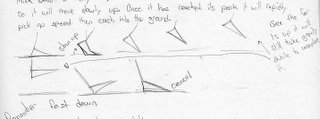Weight is a key ingrediant of animation. Without proper weight your animation won’t work.
Definition: The more mass an object has the more energy it takes to defy gravity. A heavy object will not move up quickly (unless acted upon with a termendous force) Once a heavy object is up it takes a lot of energy to keep it up. Once it starts coming down (again unless acted upon) it will come down fast. It takes a lot of energy to defy gravity at all levels).
Think about a heavy step. It takes a lot of energy to pick up that heavy foot, so it will move up slowly. Once it has reached it’s peak it will rapidly pick up speed, then crash into the ground.

REMEMBER:
Timing: how long you hold a pose or the time it takes to make a move.
Spacing: How you move from pose A to pose B (ie fast in/ fast out; fast in/ slow out; etc)
Phrasing: How you group together and transition through mutilple actions. (or another way to put it) how quickly you move through a section of animation using timing and spacing.
There is more to weight than timing. Staging and camera angles play a part too.
MAYA TIP:
-To quickly select the different rotation modes (gimble, local, global) hold down the "E" key and select the active window, then chose your mode.
-This works the same with the translate mode and the "W" key.
HOW TO SOFTEN A KEY POSE (or How to add weight to a pose)
If you are animating a bouncing ball and you think that the key pose of the ball in the air is "hitting too hard"
In order to soften up pose # 2 to add some weight go to the graph editor and in spline mode do the following. Add two new keys a frame or two near your old key pose, stretch them out and then delete the original key # 2 pose.
This will enable the ball to float there slightly longer. DON’T RELY ON ADJUSTING THE TANGENTS ON THE SPLINE CURVES TO FIX THINGS. You need to add more keys to better define the path of motion.
Poses and Timing have a connected relationship
"If it is a weight problem, take a look at your poses and if your poses hold up pretty good your weight will be seen in timing" – Keith
Translation: Timing is the meat of most weight problems. Pose fixes will strength a timing fix to a weight problem. But Pose fixes only rest on the foundation of Timing.
The same ten poses of a walk cycle can basicly work for a slow heavy walk and a fast light walk. Just the timing will be different.
"ANIMATION COMES DOWN TO POSE AND TIMING KIDS!"
Shot Heads & Tails
1)Action within the first/last 6-8 frames of a shot won’t have enough time to properly register with the audience.
2)Any movement that ends within the first 6-8 frames must be a finishing of a move started in the previous shot.
3)Any move started within the last 6-8 frames of a shot must be shown finishing in the following shot.
4)Moves that occur within the shot can finish up in the last frame. Just don’t start a new one.
No comments:
Post a Comment